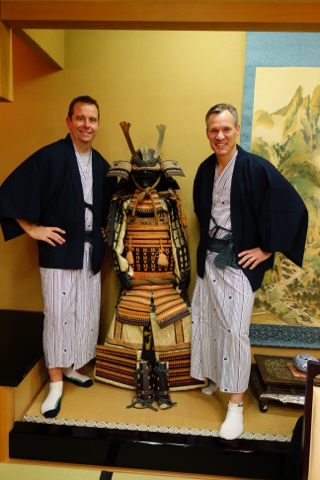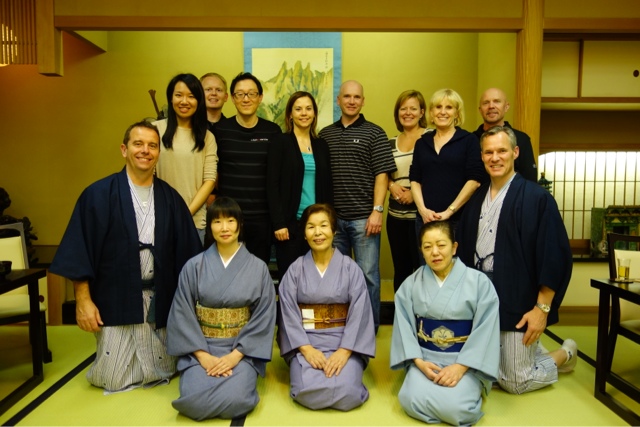How can you empower your teammates to be co-responsible for quality?
Friday, November 30, 2012
Weekly Hansei: Quality is Everyone's Responsibility
How can you empower your teammates to be co-responsible for quality?
Thursday, November 29, 2012
Japan Trip Video
Each Japan Lean Tour is a fun filled learning experience. This particular Japan trip was extra exciting as the Blackbelts surprised the conservative nation with a flash mob.
Tuesday, November 27, 2012
Our Amazing Video!
Please take a look at our newest video showcasing our programs and philosophy! We are proud to be an agent of change in the world of lean.
Monday, November 26, 2012
Huddle Up
Last week, we talked about hansei for reflection at the end of the day. Today we are addressing the morning huddle to start another productive day.
Morning huddle, scrum, discussion, meeting, check in… Whatever you may call it, convening at the beginning of the day is a great way to strategize the entire team and optimize efficiency.
Morning huddle, scrum, discussion, meeting, check in… Whatever you may call it, convening at the beginning of the day is a great way to strategize the entire team and optimize efficiency.
This is also a way to build relationships and trust within the team. As each team member is given a chance to loosely share what their plan for the day is and anticipated areas of difficulty, the team can identify how the load can be leveled. By laying your cards on the table so to speak, potential redundancy is identified and eliminated. Connections between each team members’ roles and work will arise during these meetings as well.
Here is a video summarizing the main points you should cover to conduct an effective morning huddle, followed by a demonstration.
Here is a video summarizing the main points you should cover to conduct an effective morning huddle, followed by a demonstration.
Now, you are fully equipped to lead your team in a morning huddle!
Labels:
greenbelt certification,
hansei,
lean,
morning huddle
Friday, November 23, 2012
Quick and Effective Hansei in 5
“Life can only be understood backwards; but it must be lived forwards.”
― Søren Kierkegaard
A hansei is a concise meeting to reflect on the events of the day. It is a supportive way to facilitate learning and ultimately to conclude the day on a positive note.
Here are 5 tips for a 5 minute hansei:
1. Stand up – this is a psychological signal that the meeting is intended to be concise.
2. Rotate the role of the meeting facilitator who will be responsible for time management.
3. Identify "hot issues" from the day and how they can be prevented the next day. Be sure to solicit the team for integrated solutions.
4. Recognize performance and celebrate successes.
5. Know when to stop. Hansei is not meant to beat yourself up or place blame on team members. The purpose of hansei is honest reflection of self and the team as a single unit to perpetuate continous improvement.
Wednesday, November 21, 2012
Yokotan and Great presentations
Last week's Toronto Greenbelt class achieved $150,000 worth of savings. This particular three day kaizen which focused on cycle time reduction yielded an average of 40% savings in change-over time. The teams tackled the most problematic processes in the extrusion products, which formed the basis for the kaizen.
You've heard of the importance of sharing successes. Lean thinking recognizes this fact and successful kaizens always follow up with "yokotan" - the sharing of learning and improvements across the organization so that all will benefit. Part of a successful yokotan is being able to tell the story through a cogent, convincing presentation. In the Greenbelt Program, participants have the opportunity to hone their presentation skills.
Here are five tips that we suggest participants keep in mind for a polished presentation.
You've heard of the importance of sharing successes. Lean thinking recognizes this fact and successful kaizens always follow up with "yokotan" - the sharing of learning and improvements across the organization so that all will benefit. Part of a successful yokotan is being able to tell the story through a cogent, convincing presentation. In the Greenbelt Program, participants have the opportunity to hone their presentation skills.
Here are five tips that we suggest participants keep in mind for a polished presentation.
- Near the beginning of your presentation, ensure there is a slide highlighting the key takeaways your audience should get out of the presentation. If you are not using Powerpoint, simply verbalize them. This helps your audience identify what to listen for.
- Display your presentation on both the projector screen and your laptop, then try to only look at the laptop when talking to the audience. Try to avoid the tempation to look at the screen, since this means that you will end up turning your back to the audience.
- To minimize the inevitable "fidgeting", hold a pen (that doesn't click) or something else in your hand so that your mind can just focus on talking.
- Don't memorize an entire speech. Just have your most important points at the top of your mind or on cue cards. Your presentation will be more natural and you will feel more at ease because you won't be trying to regurgitate every single word.
- Conclude your presentation by summarizing your main takeaways. This serves to drive home your point and close the circle from beginning to end.
How much importance do you place on the delivery of the message?
Suggested readings: Crucial Conversations - Stephen R. Covey, How to Improve Your Presentations
Monday, November 19, 2012
The Power of Simplicity
A hallmark of Lean Thinking is simplicity. We can address simplicity in the physical aspects of our jobs or processes. For example, placing our tools within close reach makes it easier for us to do our job (5S). This may mean rearranging the work area but in doing so we address one of the eight types of waste - unnecessary movement. Sounds too simple (no pun intended)? You'd be surprised how much easier and more efficiently a job can be completed.
Simplicity can be applied to intanglibe aspects of a business too, and often we see how effective the results can be.
A real world example is Ford's "One Ford" campaign, involving the integration of "its international units and simplification of its global structure. Ford was profitable despite industry woes in the first part of 2008 and did not require government assistance."
A non-convoluted process will win your customers' loyalty too. Making it simple for your customers shows respect for their time and makes your organization transparent. Needless to say, this will have positive effects on the underlying relationship you have with your customers.
Sources:
Harvard Business Review Blog
The Next Big Thing
In Simplicity We Trust
Friday, November 16, 2012
Hide and Seek is for kids. Go and See is for Successful Business
You remember the game, Hide and Seek? You close your eyes and you wait. Then you spend a long time looking. In the game you're having fun looking for your friends; but in a business it is no fun when you have to go looking for where your issues are.
The most effective Lean leaders do not hide from where the work actually happens. They go to the shop floor everyday and look for flow, essentially how smoothly (or not) the business is running. Small issues can be identified right away and managers and employees can collaboratively come up with solutions on the spot. In this way, larger issues are prevented. In Japanese, this concept is referred to as Genchi Gembutsu.
No matter what the issue is, Genchi Gembutsu is fundamental to understanding the process and the issues. That is why Greenbelts are trained to engage in Genchi Gembutsu for all kaizens and homework assignments. Below are photos showing Greenbelts employing the concept of Genchi Gembutsu at an Ontario based extrusion coated and laminated product provider.
The most effective Lean leaders do not hide from where the work actually happens. They go to the shop floor everyday and look for flow, essentially how smoothly (or not) the business is running. Small issues can be identified right away and managers and employees can collaboratively come up with solutions on the spot. In this way, larger issues are prevented. In Japanese, this concept is referred to as Genchi Gembutsu.
No matter what the issue is, Genchi Gembutsu is fundamental to understanding the process and the issues. That is why Greenbelts are trained to engage in Genchi Gembutsu for all kaizens and homework assignments. Below are photos showing Greenbelts employing the concept of Genchi Gembutsu at an Ontario based extrusion coated and laminated product provider.
Reflection: How many times a week or even in a month, do you visit the gemba? How would visiting the gemba more often help you with your work?
Wednesday, November 14, 2012
Are all Work Groups Teams?
Not all working groups are "teams". A team is a cohesive group of people committed to reach a common goal.
Understanding and mutually respecting each member's personality is a key component to a productive team dynamic.
The significance of effective team work is addressed in Module 2 of Lean Sensei Greenbelt certification. The team dynamic component involves a complete Myers Briggs Type Indicator (MBTI) assessment. During this exercise, Greenbelts learn about the 16 personality types and how to leverage this knowledge to foster effective teams.
Over the next two weeks, what is one thing could you do differently to improve your team's overall effectiveness?
Understanding and mutually respecting each member's personality is a key component to a productive team dynamic.
The significance of effective team work is addressed in Module 2 of Lean Sensei Greenbelt certification. The team dynamic component involves a complete Myers Briggs Type Indicator (MBTI) assessment. During this exercise, Greenbelts learn about the 16 personality types and how to leverage this knowledge to foster effective teams.
 |
| Last week's Calgary Greenbelts preparing for the Team Dynamics exercise |
Saturday, November 10, 2012
Friday, November 9, 2012
Weekly Hansei: Achieve the Unachievable
As we reflect on the past week, commend yourself on one thing that you accomplished. Reflect on how far away the goal seemed at first. If you can imagine it, then somehow you can make it a reality. The question is not "is it possible?", but "how shall I accomplish it."
Go Transform the World
Lean Sensei International
Wednesday, November 7, 2012
Supermarkets Without Real Food
Supermarkets in China, South Korea and other parts of South Asia have spotted an opportunity to provide customers with a convenient service. Shoppers can use their time, while waiting for public transit, to run household errands… namely, grocery shopping.
Supermarkets are being built in train stations but they do not have any real food. Grocery items are represented by QR codes. Shoppers simply use their smartphones to scan the QR codes and pay for their purchases online. The grocery items are then delivered to their homes.
Waiting time - one of the seven types of wastes - has been transformed to offer a value added service to customers and in doing so, improve the supply chain.
Waiting time - one of the seven types of wastes - has been transformed to offer a value added service to customers and in doing so, improve the supply chain.
Monday, November 5, 2012
Start of The Week, Start of Change
It's the start of a new week so what better time to think about Kaizen. A successful Kaizen blitz not only yields positive change but imparts Lean philosophy in a sustainable manner. The chart below summarizes the dynamic preparation model that leads to successful Kaizen.
 |
| click to enlarge |
First and foremost, understand what value means to your customer. Currently, is that what you are producing?
Map out your future goals to align your business objectives to bringing value to your customers.
Mind the gap- compare your current state with your future state, where you want to be?
What will you do to get there?
Plan it out and do it! Have checkstops along the way to evaluate your progress and revise future state as necessary.
What business process at your organization can you lead Kaizen for?
Saturday, November 3, 2012
Friday, November 2, 2012
Kaiseki dinner
Executives stayed extra day in Kyoto as part of networking and brainstorming. We were able to discuss key take aways while enjoying (mostly fish) kaiseki dinner.
Thursday, November 1, 2012
Subscribe to:
Posts (Atom)







.JPG)
.JPG)
.JPG)
.JPG)
.JPG)




































